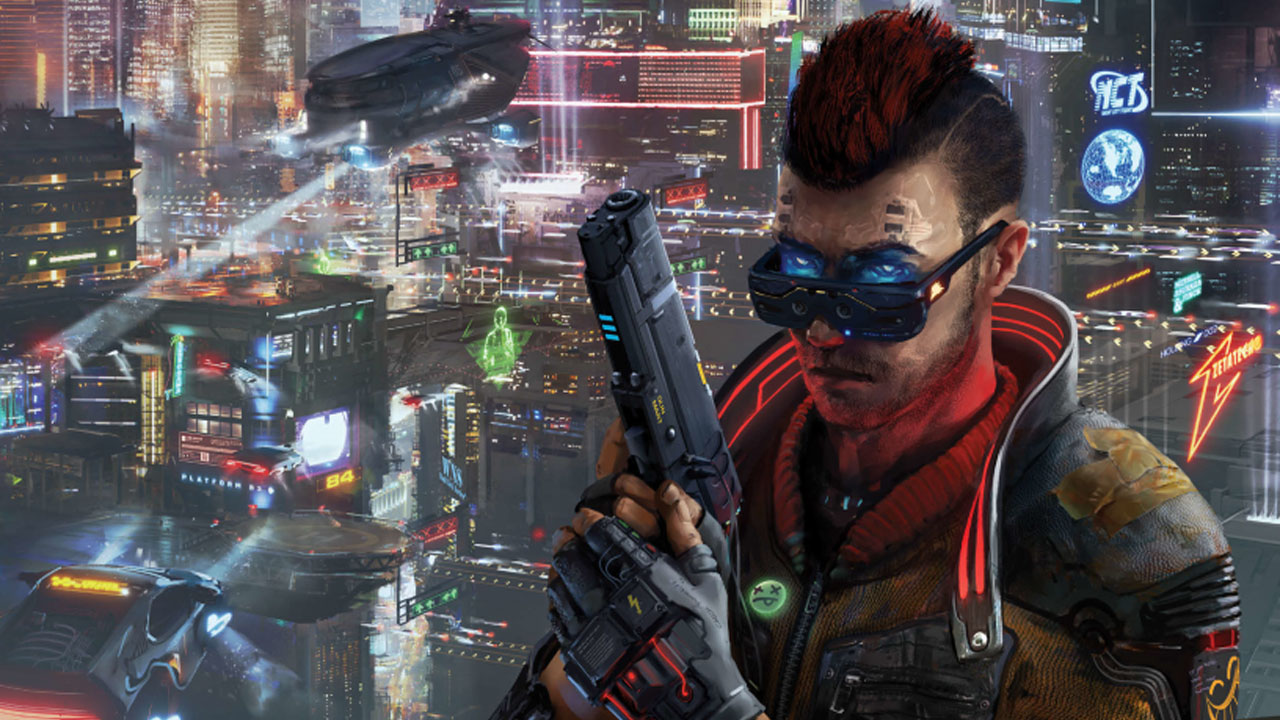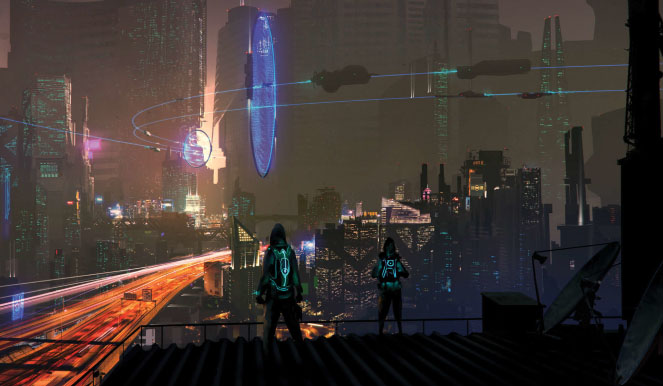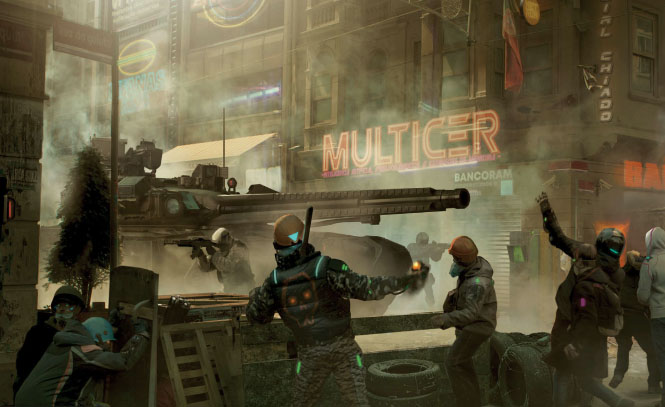A guide to Cyberpunk Red, the latest edition of the tabletop game
Cyberpunk Red is a tabletop RPG sharing its world with Cyberpunk 2077. Is it worth plugging your datajack into?

In Night City, even the sky glows neon. Radioactive fallout from the Fourth Corporate War has turned dusk and dawn red, some districts are nothing but rubble and abandoned combat tanks, while others have been reclaimed and thrive again.
This is the setting for Cyberpunk Red, a tabletop RPG in the same world as Cyberpunk 2077, but a few decades earlier in the year 2045. It’s a pen-and-paper RPG played with dice and character sheets, like Dungeons & Dragons or Call of Cthulhu, a format for games that’s seen a popular resurgence in recent years.
The best explanation of tabletop RPGs is still that given by Abed in Community: “This is a roleplaying game. It takes place entirely in our collective imagination. I tell a story and you make choices in the story.”
Hardwired
Both Cyberpunk 2077 and Cyberpunk Red owe their existence to a tabletop RPG designed by Mike Pondsmith and published by R. Talsorian Games in 1988. Its rules have been through several iterations, the most popular version being Cyberpunk 2020, which described a corporate-run Night City in the Free State of Northern California in what was then a hard-to-imagine near future. As the actual year 2020 approaches, Cyberpunk Red moves the setting forward, streamlining rules and assumptions along the way.
Pondsmith describes the relationship between R. Talsorian’s tabletop RPGs and CD Projekt Red’s videogame by comparing them to Star Wars, saying that if his original game was the first movie, “right now Talsorian is running The Empire Strikes Back, while 2077 is essentially Return of the Jedi or beyond even.”
The first taste of Cyberpunk Red is a ‘Jumpstart Kit’, a set of rules aimed at beginners. There’s a worldbook that outlines the setting, complete with an introductory scenario and a set of six ready-made characters with roles like Rockerboy, Tech, and Nomad to choose from. A full-length rulebook is currently being written, with R. Talsorian running on Valve Time: ‘It’ll be done when it’s done.’ Right now, the jumpstart kit is enough to get your first game of Cyberpunk Red going.
Red scare

Night City as portrayed here is the same place we’ve seen in footage of Cyberpunk 2077, with districts such as beachfront Pacifica and details like the elite paramedics of Trauma Team very much in evidence. Yet this version of the city is being rebuilt after a war—its skyline full of cranes and its radioactive corporate zone only visited by desperate scavs.
The biggest gaming news, reviews and hardware deals
Keep up to date with the most important stories and the best deals, as picked by the PC Gamer team.
Nomad packs, road warriors from the hellscape between cities, have been recruited to help with the reclamation—presumably if you can drive an armoured battletruck you can handle bulldozers.
The internet’s broken too, thanks to future wars being fought online as wells as in meatspace. Jacking directly into cyberspace can cook your brain, so people rely on lower-tech solutions, airgapped local networks and a CitiNet that’s geographically restricted and only slightly more advanced than the modern web. The world’s most advanced AIs have all taken the opportunity to flee to a secure ‘Ghost World’ on a system in the abandoned ruins of Hong Kong run by a ghost in the machine named Alt Cunningham, which sounds like something the videogame could well follow up on.
Though there are hints of what’s to come, the focus is on describing the world in ‘the Time of the Red’ so you can run your own games there. It’s a setting where designer drugs are legal and people wear armoured jackets down the street, unions don’t exist and corporations make employees sign lifetime contracts. Segotari sells interactive braindance games with names like Elflines Online, there’s a world currency, and posergangs biosculpt themselves to look like characters from The Brady Bunch and The Wizard of Oz.
It’s got a sense of humour even as it bills this as a ‘dark future’, but that was true of Cyberpunk 2020 as well, with its clown gangs and red-and-black glowing holozones denoting which areas of the street were no-parking zones in the event of a Free Fire Emergency because vehicles there could legally be used as barricades by police or corporate units.
It may contain some daft jokes and satire, but it’s still a dystopia. One section of Night City has been abandoned by the police and become a combat zone, where gangs like the cybered-up Iron Sights and neo-fascist Red Chrome Legion rule. It’s not a nice place to live, but an exciting place for games.
She's incredible math

Cyberpunk 2020 had an elegant central mechanic, but incongruously complicated rules for combat. It was a game that preached style over substance and yet had rules for fighting designed so that over time they would statistically resemble the results of the FBI’s Uniform Crime Reports. Those rules were called Friday Night Firefight. Cyberpunk Red calls its combat rules Thursday Night Throwdown, and explains that there will be a fuller version to come in the core rulebook.
These rules combine fiddliness and abstraction, so I’m not sure they’ll please people who want cinematic, narrative fights or those who want to know the diameter of exit wounds in millimetres.
A nice addition is the rule for what happens before a fight, called the Facedown. Characters add their Reputation and Cool scores to the roll of a d10, and whoever wins intimidates the other. The loser can back down or fight on, but will take a -3 on every roll.
As for netrunning, it was always a pain in Cyberpunk 2020 because, though it took seconds from the hacker’s perspective, it took ages at the table, and could be done from the couch before a mission even started. Now, netrunning is something you have to do up close, wirelessly but within six meters of an access point, and it plays out in real time. While the netrunner is running Banhammer to defeat Black ICE, the rest of the party can be holding off the guards.
That’s fun, but almost all of the netrunner’s abilities and programs boil down to their Interface stat versus a difficulty value. If they beat it they move on to another challenge, if they fail then things stall. Still, it’s an improvement over the old rules.
My players had fun with character creation. The Jumpstart Kit provides six pre-generated characters with names and faces though the rules suggest changing those and I heartily recommend it, just for a sense of ownership. Then you make a lifepath for them. A selling point of the Cyberpunk games, lifepaths present you with tables that delineate your life before the game starts.

It’s likely you’ll have more enemies than friends, and two of my players came out with zero pals, which immediately says something about them as people. Deceased family members are common, along with kidnappings and betrayals. The book explains that the versions of lifepaths presented here are truncated, and the rulebook will give them more substance, but even these miniature lifepaths gave my players rich backstories full of ideas for future plotlines I could run.
Screamsheets
The last thing in the Jumpstart Kit is a set of beginner adventures, the first of which is fleshed-out while the rest are left as notes. This intro scenario is called The Apartment, and it casts all the PCs as living together in a building that’s about to be violently taken over. The siege can play out in multiple ways, and I appreciate the freedom to mould it to your players with suggestions based on what abilities they have. One of the options is to have the neighbours betray them, but my players immediately bonded with the kooky NPCs, so I’m glad I threw that out.
One thing missing is an equipment guide with prices and names. Most of the gear on the character sheets is plain, a Very Heavy Pistol or a Groundcar, but cyberpunk’s a genre where nameology matters, where you want to be able to whip out a Malorian Arms Flechette Pistol and have it mean something.
Still, all my complaints are minor quibbles. It’s effective at creating a mood, and my players immediately understood the vibe—one’s playing a wannabe pro gamer named Zigz, while another’s got a tragic past and calls himself Jack Saturday. The gold standard for beginner RPG products is still the D&D Starter Kit, and the best introduction to roleplaying will always be enthusiastic friends who are already into it, but failing that Cyberpunk Red’s Jumpstart Kit and a viewing of Blade Runner or Bubblegum Crisis does the job admirably.

Jody's first computer was a Commodore 64, so he remembers having to use a code wheel to play Pool of Radiance. A former music journalist who interviewed everyone from Giorgio Moroder to Trent Reznor, Jody also co-hosted Australia's first radio show about videogames, Zed Games. He's written for Rock Paper Shotgun, The Big Issue, GamesRadar, Zam, Glixel, Five Out of Ten Magazine, and Playboy.com, whose cheques with the bunny logo made for fun conversations at the bank. Jody's first article for PC Gamer was about the audio of Alien Isolation, published in 2015, and since then he's written about why Silent Hill belongs on PC, why Recettear: An Item Shop's Tale is the best fantasy shopkeeper tycoon game, and how weird Lost Ark can get. Jody edited PC Gamer Indie from 2017 to 2018, and he eventually lived up to his promise to play every Warhammer videogame.

